Biscoff Mascarpone Icebox Cake
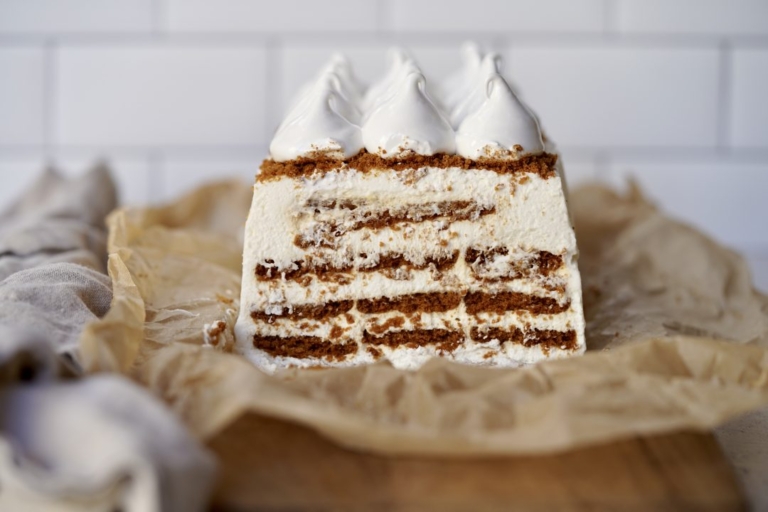
You can’t avert your eyes and you know it. It’s a Biscoff mascarpone icebox cake and it is killer. This beauty is the easy, prep-ahead holiday dessert you’ve been looking for. Building an icebox cake is not difficult, the trick is chilling the cake untouched. Overnight, magic happens. The cream will soften the cookie layers in the cake, and you will end up with the perfect soft, creamy, not to mention fluffy, icebox cake that requires no baking whatsoever. Score.
But before I speak more about this lovely Biscoff mascarpone icebox cake, let me share a little history about these amazing biscuit cookies most of us had a billion times without even knowing it.
The History of Lotus Biscoff
Known in Europe as Lotus Speculoos, this cookie was invented in Belgium, in the town of Lembeke, in 1932. Biscoff cookies have been baked according to the original recipe since their invention. These famous caramelized biscuits are made from natural ingredients and because of it’s simplicity, the Boone brothers named them “Lotus“, after the flower that symbolizes purity.
The Boone Brothers decided to introduce their Lotus cookie paired with coffee to attract more attention. Biscoff and coffee became an instant hit and the uniquely spiced cookie skyrocketed in popularity in Europe shortly after being served at the 1958 World’s Fair. By 1960 the biscuit and coffee trend became a routine in Belgian and Biscoff cookies were quickly crowned Europe’s favorite cookie. Around the late 1980s, these famous biscuits made their way across the pond. Once in North America, the name Lotus Speculoos quickly got changed to “Biscoff,” a combination of the words “biscuit” and “coffee“, meant to highlight what this cookie did best: pair with a cup of coffee.
Biscoff And Delta Airlines
The Belgian cookie first appeared stateside in the late ’80s, but that would not have happened without the help of Delta Air Lines. Delta was the first to popularize the cookie and, during pre-pandemic times, handed out over 80 million packages of the buttery, crumbly, spiced cookies each year.
Over the past 30 years, these simple cookies have been served as the on-board snack of many domestic airlines and a few international carriers. Biscoff is now also available all over the country in grocery stores and as “cookie butter,” a tasty spread made from the well-known cookie itself.
America can thank a US-based food broker, Michael McGuire, for discovering Biscoff cookies. McGuire was traveling in Europe, where he tasted the cookie and liked it so much that he brought it back to the US and introduced it to Delta. The airline did not hesitate, snapped it up, and began serving Biscoff cookies in-flight around 1985.
According to Dan Mord, general manager of domestic product design for Delta, with their long history in the in-flight food space, neither he nor his colleagues, are aware of any other food success of the same magnitude. The Biscoff cookie “has become an iconic part of the Delta brand itself.”
Delta first began by serving a smaller package of Biscoff cookies, but now, Delta serves a bigger double pack and each cookie is emblazoned with Delta’s name. That is branding like no other.
Icebox Cake Invention
The icebox cake is derived from similar desserts such as the Charlotte and the trifle, but made to be more accessible for housewives to prepare. Icebox cakes were first introduced to the United States in the 1930’s, as companies were promoting the icebox as a kitchen appliance.
The trick to making the perfect icebox cake is all about the chill time. It’s best to chill an icebox cake in the refrigerator, lightly covered with plastic wrap, for at least 8 hours, but preferably overnight. If the cookies you are using are very thin, less chill time could work, but the fluffy cake-like texture is only obtained with longer chill times.
Icebox Cake Myth
Contrary to popular belief, an icebox cake is not a frozen dessert. An icebox cake should never go in the freezer, despite the “ice” in the name. The icebox name relates to the invention of refrigeration itself. An icebox (also called a cold closet) was a compact non-mechanical refrigerator that was common in the early-twentieth-century, before electric refrigerators were invented, iceboxes were referred to as “refrigerators“. Only after the invention of the modern-day electric refrigerator did early non-electric refrigerators become known as iceboxes. The terms icebox and refrigerator were used interchangeably in advertising as long ago as 1848.
Now that I’ve cleared up that confusion, nothing should be stopping you now. People tell me often, “I hate to bake” or “I hate making cakes because I’m terrible at it“, well, this Biscoff mascarpone icebox cake is your answer to that. And it’s honestly foolproof. Just make sure to get those biscuits soon, they fly off the shelves around the holiday season.
Biscoff Mascarpone Icebox Cake
Ingredients:
For the Icebox Cake:
- 8 ounces mascarpone cheese
- 2 1/4 cups heavy cream
- 3/4 cup Confectioners’ sugar
- 1 teaspoon vanilla extract
- 1 package Biscoff cookies
For the Swiss Meringue Topping:
- 4 egg whites
- 1 cup sugar
- Pinch of Kosher salt
- 2 teaspoons vanilla extract
Directions:
- For the Mascarpone Cream: Using a kitchen mixer, such as a Kitchen Aid, fitted with a whisk attachment, add the mascarpone cheese and beat on medium-low. With the mixer running, slowly add 1 cup of the heavy cream and mix until the mixture is a more liquid consistency and the mascarpone is blended.
- Add the remaining heavy cream and increase the speed to high, covering the mixer with a splatter shield or a kitchen bowl if needed. Beat until soft peaks have formed. Reduce the speed to low and add the sugar, mix until incorporated and stiff peaks have formed. Lastly, add the vanilla and mix to blend. Set near your work station.
- To Assemble the Icebox Cake: Line a standard loaf pan with parchment paper. Spread a generous amount of mascarpone cream onto the bottom of the prepared pan. Note: when arranging the cookies the placement does not need to be done perfectly, and may very based on the style of loaf pan being using. If the pan is narrower at the bottom, you will use about 4 cookies to make your first layer. You may need to cut or trim some of the cookies to get them to fit nicely in one layer.
- Add about 1/3 of a cup of mascarpone on top of the cookie layer using an offset spatula to smooth out as best as possible. Continue layering the cookies, (the next layers should average about 6 cookies each) and cream until you get to the top and have used up all but a couple cookies which can be used for serving the cake. You should have about 5 layers when you're done. Spread the top with a layer of cream, reserving a little extra cream for serving.
- Loosely wrap the icebox cake with a sheet of plastic wrap and place into the refrigerator. Let the icebox cake chill in the refrigerator ideally overnight. Refrigerate the extra cream for serving.
- To Serve: Invert the cake onto a serving platter. Using an offset spatula, add the extra cream to the sides of the cake and cover any cookies visible form the ends. Place the extra cookies in a small plastic bag and use a rolling pin to crush. Sprinkle the cookie crumbs on the top of the cake. Refrigerate the cake while you make the meringue topping.
- For the Swiss Meringue Topping: In the bowl of the kitchen mixer add the egg whites, sugar, and salt.
- In a medium size saucepan add a few inches of water and bring to a simmer. Set the mixer bowl over the simmering water, making sure the water does not touch the bottom of the bowl. Gently and continuously stir the mixture until the egg whites are very warm to the touch and the sugar has dissolved completely, about 2 minutes.
- Place the mixer bowl in its stand and fit with a whisk attachment. Beat the meringue on medium-low speed until foamy, about 2 minutes. Gradually increase the speed and beat until you stiff peaks are formed. Note: the meringue should droop only slightly when you lift up the whisk, and the bottom, about 4 minutes. Add the vanilla and mix to blend.
- Place the meringue in a pasty bag fitted with a large plain or decretive tip. Remove the icebox cake from the refrigerator and pipe small, same-size decretive dollops, about 3 per row width-wise, 7 rows total length-wise. Repeat until the entire top of the cake has been decorate. Slice and serve.

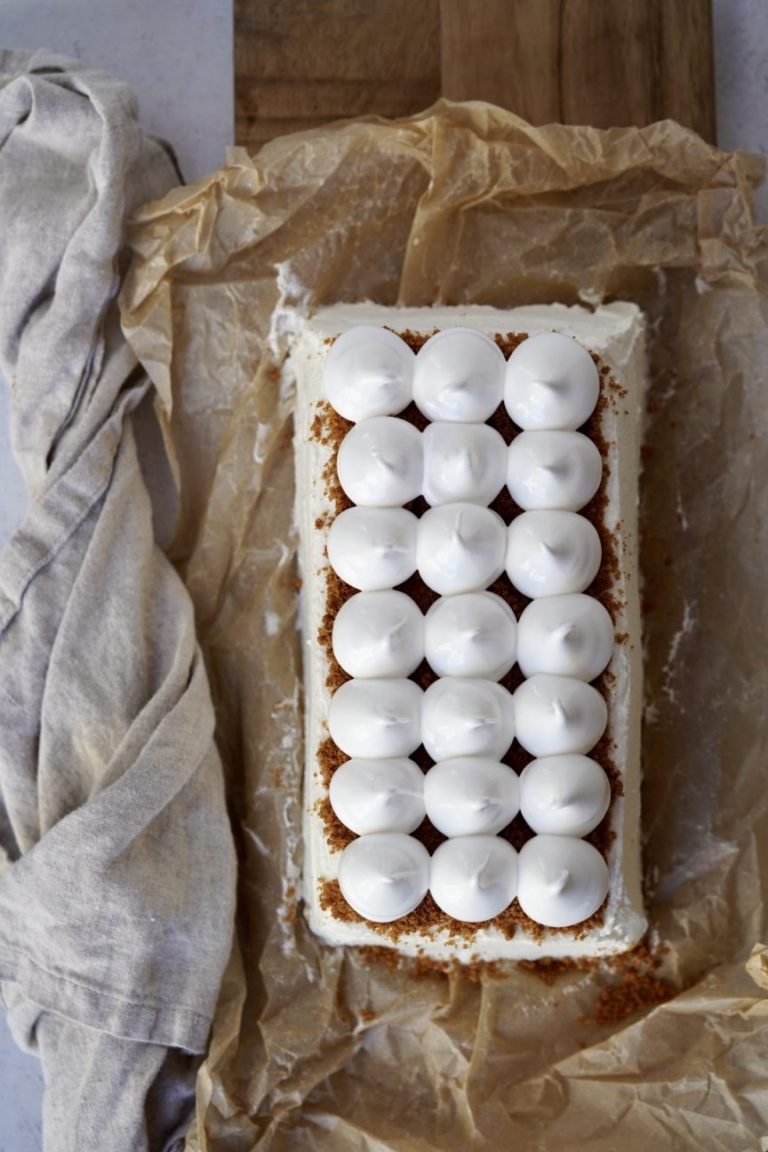
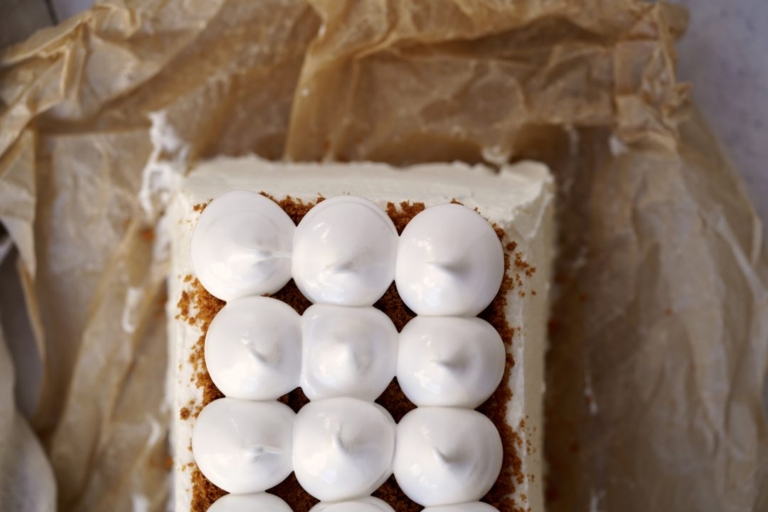
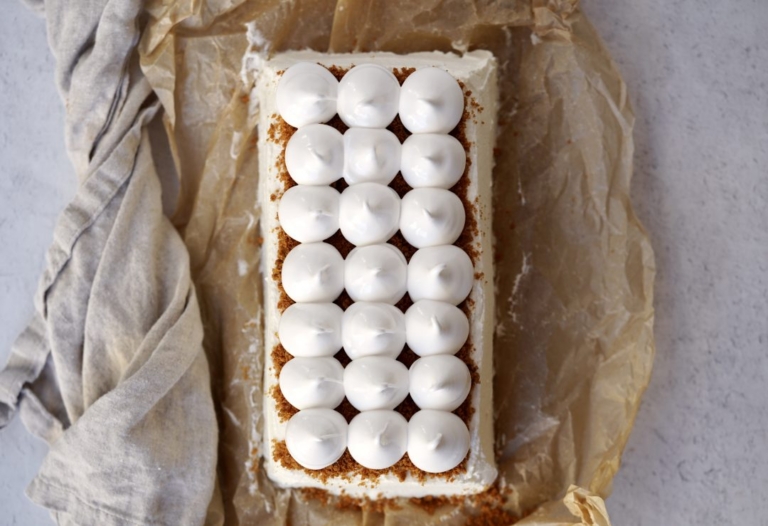
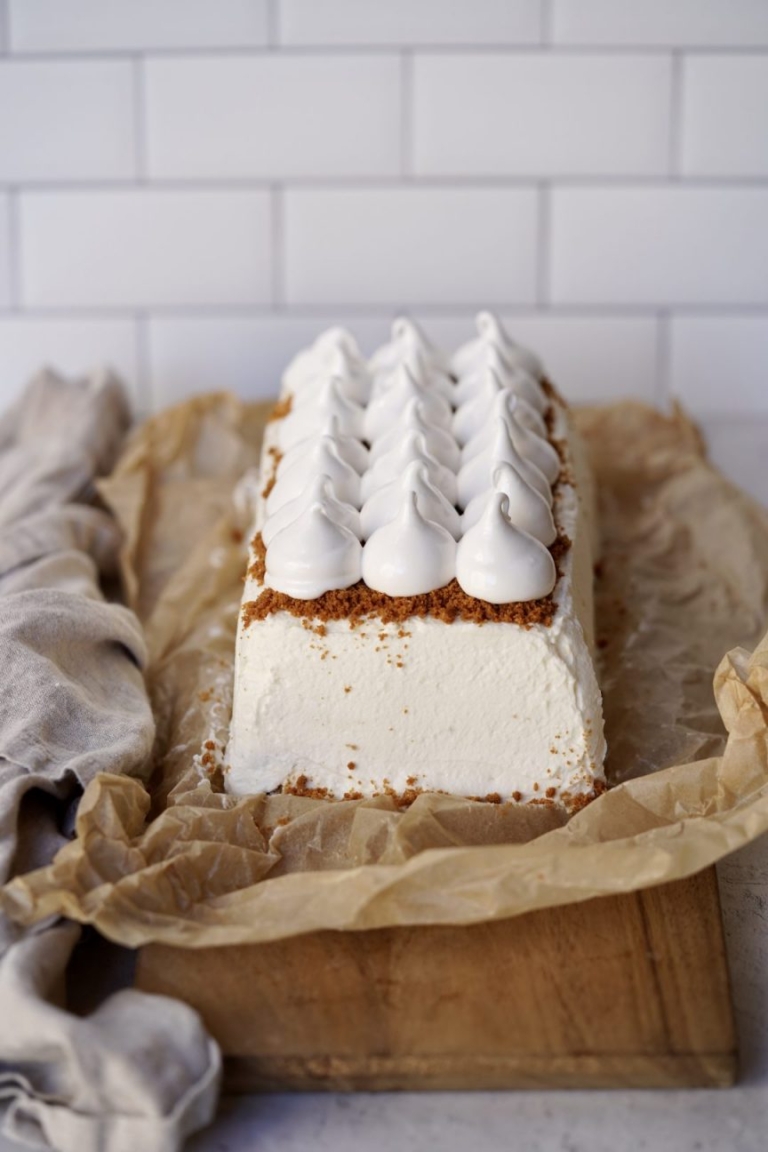
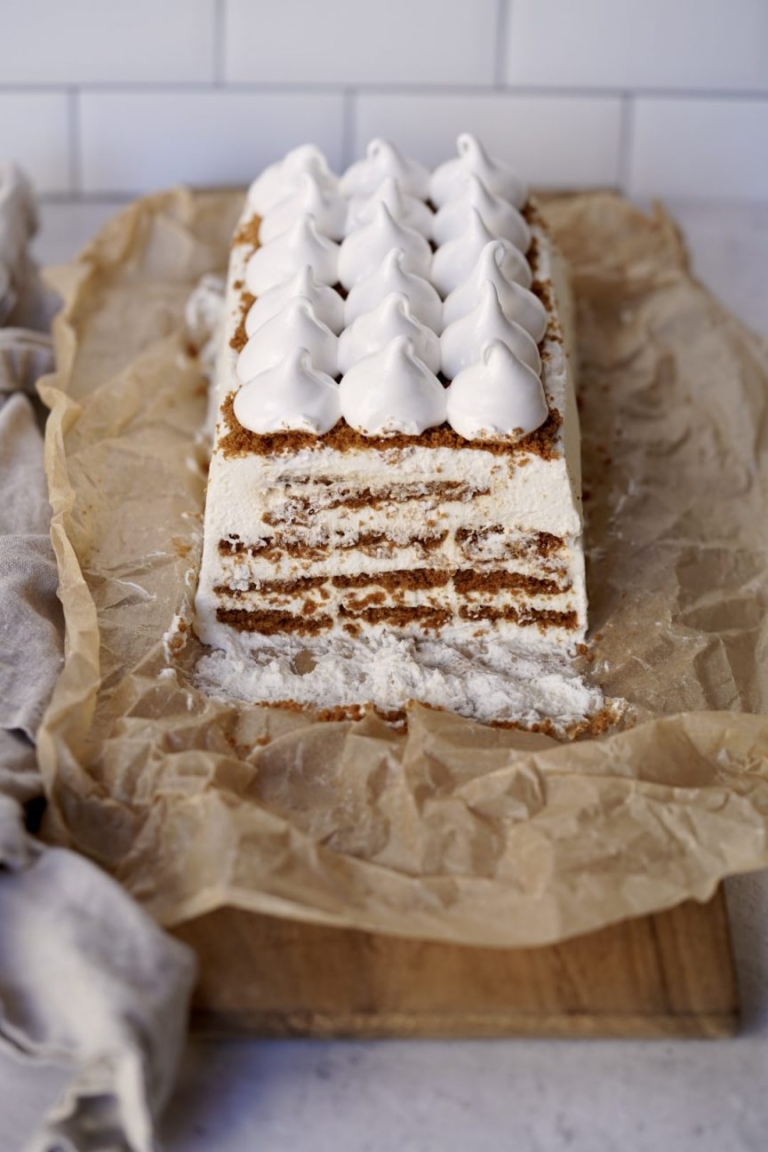
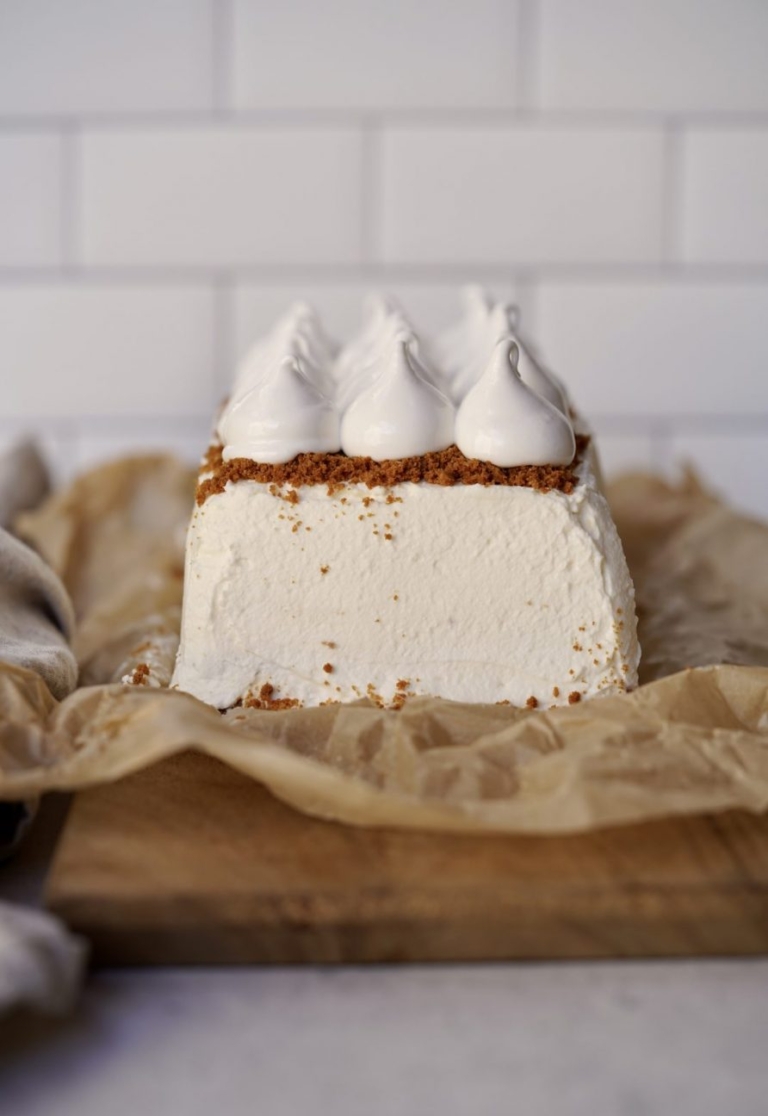


Can this cake be frozen before added the Swiss merengue?
Hi Sheila. Thanks for reaching out. Sorry for my delay, I have been traveling. This is not a cake that can be made and frozen in advance of serving. Anything with whipped cream is tricky and I don’t typically advise it. One can always try and see how it turns out, but I would be concerned it gets too mushy/watery.
Amazing. Everyone loved this dessert and my friends still talk about it after quite a lot of time has passed!
Hi Michelle- This is so lovely to hear! I am so glad you enjoyed this fun dessert. Thank you for sharing your thoughts, for reading my posts, and for making my recipe. I hope you try others!
Made this for Christmas dinner/dessert and OH MY so easy and delicious! Loved by all!! I will say I could have cut the amount of meringue I made in half because I didn’t come close to using it all, but I’ll just come up with some other use for it!
So happy you liked this recipe. You are right, it yields a good about of Swiss meringue. Hard to make a little, but I like to slice and serve more on top each slice or decorate the bottom of the cake before serving.